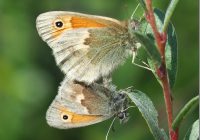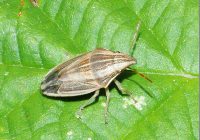Dr Phil Smith’s Wildlife Notes
August 2018
In this driest and hottest summer since 1976, the blessed relief of at least some rain on 12 August days helped to temper the worst effects. However, the damage and costs to the country became increasingly evident, with agriculture reporting production losses of 50% or more. Not to worry, rather than celebrating desperately needed rainfall, the TV weather presenters described the only really wet day during the month (26th) as “Soggy Sunday”!
In the July notes, I mentioned that the heatwave had caused many insects to emerge several weeks earlier than normal. This continued during August. Although some groups, such as grasshoppers and shieldbugs, seemed relatively unaffected, populations of others collapsed. There were much lower numbers of late-summer dragonflies than usual, though I was pleased to find several Migrant Hawkers, including two mating pairs, at Birkdale on 21st. Even more apparent was the decline in second generation Northern Dune Tiger Beetles. The mid-August coastwide survey of this iconic species by Gems in the Dunes was a write-off, volunteers finding hardly any where three weeks earlier there had been enormous numbers.
The latest statistics from the UK Butterfly Monitoring Scheme shows the Wall and Small Heath rank among the most severely declining species. Fortunately, we still have viable duneland populations, good numbers of second-brood Small Heaths appearing late in the month.
I often say that I expect to find something new and different every time I go out. This was reinforced during August. It all started on 8th when I was amazed to find a Heather Shieldbug on Freshfield Dune Heath Nature Reserve. Although widespread nationally, this insect is known to be local and elusive. The last record for the heath was in 1997 and it has not been seen anywhere else in the South Lancashire vice-county. This visit was a precursor to a fully-booked workshop on grasshoppers and shieldbugs organised by Liverpool Museum’s Tanyptera Project on 11th. With 16 people searching the dune heath in sunny conditions, we found all three of the Sefton Coast’s grasshoppers and eight species of shieldbug, including the Bishop’s Mitre which has only recently appeared in the region.
Another major find came on 8th when I joined Trevor Davenport and Patricia Lockwood for our annual trip to the wonderful Highfield Moss Nature Reserve, near Golborne. This site is outstanding for peatland specialists, such as Black Darter, Common Hawker and Meadow Grasshopper and we soon found them. However, while searching the dense clumps of Purple Moor-grass for grasshoppers, I spotted something much bigger. I couldn’t believe my eyes; it was a female Long-winged Conehead, a bush-cricket that is moving north but which is not supposed to occur nearer than Staffordshire.
My next exciting discovery was on 24th during a shieldbug hunt with my trusty sweep-net at Falklands Way, Ainsdale. Remarkably, as well as five different shieldbugs, including more Bishop’s Mitres, two male Speckled Bush-crickets turned up in the net. Like the conehead, this is a southern insect, the only recent records in our region being a small colony in Trevor’s Freshfield garden from 2015 to 2017. Nearby, was a spectacular white-flowered Powell’s Cape-Lily (Crinum × powellii ‘Album’) a garden escape for which there is only one other record in the north of England – a long-established plant of the more usual pink form at Crosby Coastal Park. Returning to Falklands Way a few days later, I found several more Speckled Bush-crickets, including females, and photographed a pair mating. As is usual in crickets, the male produced a white spermatophore which was taken up by the female, something I had never seen before. Are any other colonies along the coast?
Patricia Lockwood and I conducted another botanical survey of the former Hope School playing fields, Ainsdale, an extremely rich grassland allocated for housing development in the Sefton Local Plan. Twenty-four new species raised the grand total to 204 higher plants. They included the regionally rare Lesser Centaury – a nice find.
Two field meetings at Altcar Training Camp during the month enabled conservationists, including representatives from the Fylde Coast, to see the after-effects of the major dune fire but also management to remove large areas of invasive Sea Buckthorn and Japanese Rose, creating areas of bare sand and a new Natterjack Toad breeding scrape. Older scrapes are due for re-profiling later this year, while annual mowing of the fixed dunes in the Dry Training Area has dramatically improved the vegetation. A bonus was up to 10 Painted Ladies and two Small Tortoishells on Creeping Thistle growing on the Natterjack scrape’s spoil heap, while a magnificent Short-eared Owl was a reminder of autumn passage already in full swing with large flocks of waders on the beach.




